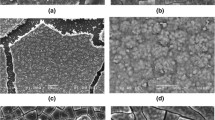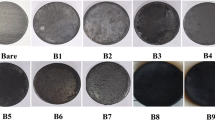Abstract
Titanium (IV) silsesquioxane was occluded in the cavities of a mesoporous silica MCM-41. The material was chemically modified with nickel hexacyanoferrate (III) (named MTTiPNiH) and subsequently characterized by spectroscopic techniques: Fourier Transform Infrared, X-ray Dispersive Energy Spectroscopy, Scanning Electron Microscopy and cyclic voltammetry. The voltammetric studies of MTTiPNiH was obtained using a graphite paste electrode which was possible to observe one well-defined redox pair with formal potential E°′ = +0.53 V attributed to FeII(CN)6 / FeIII(CN)6 in the presence of Ni2+ ions. As an application, the graphite paste electrode modified with MTTiPNiH was tested for sulphite and dipyrone detection.
Similar content being viewed by others
References
Baney RH, Itoh M, Sakakibara A, Suzuki T (1995) Silsesquioxanes. Chem Rev 95:1409–1430
Voronkov M, Lavrent'yev V (1985) In: Springer Berlin Heidelberg (ed) Polyhedral oligosilsesquioxanes and their homo derivatives
Do Carmo DR, Paim L, Metzker G, Filho NLD, Stradiotto NR (2010) A novel nanostructured composite formed by interaction of copper octa(3-aminopropyl) octasilsesquioxane with azide ligands: preparation, characterization and a voltammetric application. Mater Res Bull 45:1263–1270
Provatas A, Luft M, MU JC, White AH, Matisons JG, Skelton BW (1998) Silsesquioxanes: part I: a key intermediate in the building of molecular composite materials. J Organomet Chem 565:159–164
Shen X, Cui Y, Pang Y, Qian H (2012) Graphene oxide nanoribbon and polyhedral oligomeric silsesquioxane assembled composite frameworks for pre-concentrating and electrochemical sensing of 1-hydroxypyrene. Electrochim Acta 59:91–99
Do Carmo DR, De Castro GR, Martines M, Filho NLD, Stradiotto NR (2008) Adsorption and electropolymerization of toluidine blue on the nanostructured octakis(hydridodimethylsiloxy)octasilsesquioxane surface. Mater Res Bull 43:3286–3296
Wada K, Tomoyose R, Kondo T, Mitsudo T (2009) Preparation of porous ruthenium catalysts utilizing a silsesquioxane ligand; catalytic activity towards hydroformylation of 1-octene. Appl Catal A 356:72–79
Bourbigot S, Turf T, Bellayer S, Duquesne S (2009) Polyhedral oligomeric silsesquioxane as flame retardant for thermoplastic polyurethane. Polym Degrad Stabil 94:1230–1237
Soh MS, Yap AUJ, Sellinger A (2007) Methacrylate and epoxy functionalized nanocomposites based on silsesquioxane cores for use in dental applications. Eur Polym J 43:315–327
Mehl GH, Goodby JW (1996) Liquid-crystalline, substituted Octakis-(dimethylsiloxy)octasilsesquioxanes: oligomeric Supermolecular materials with defined topology. Angew Chem Int Ed 35:2641–2643
Lucho AMS, Pissetti FL, Gushikem Y (2004) Al2O3-coated 3-N-propylpyridinium chloride silsesquioxane polymer film: preparation and electrochemical property study of adsorbed cobalt tetrasulfophthalocyanine. J Colloid Interf Sci 275:251–256
Do Carmo DR, Paim LL, Filho NLD, Stradiotto NR (2007) Preparation, characterization and application of a nanostructured composite: Octakis(cyanopropyldimethylsiloxy)octasilsesquioxane. App Surf Sci 253:3683–3689
Feher FJ, Tajima TL (1994) Synthesis of a molybdenum-containing Silsesquioxane which rapidly catalyzes the metathesis of olefins. J Am Chem Soc 116:2145–2146
Levitskii MM, Smirnov VV, Zavin BG, Bilyachenko AN, Rabkina AY (2009) Metalasiloxanes: new structure formation methods and catalytic properties. Kinet Catal 50:490–507
Do Carmo DR, Filho NLD, Stradiotto NR (2007) Encapsulation of titanium (IV) silsesquioxane into the NH4USY zeolite: preparation, characterization and application. Mater Res Bull 42:1811–1822
Abbenhuis HC (2000) Advances in homogeneous and heterogeneous catalysis with metal-containing silsesquioxanes. Chemistry 6:25–32
Beck JS, Vartuli JC, Roth WJ, Leonowicz ME, Kresge CT (1992) A new family of mesoporous molecular sieves prepared with liquid crystal templates. J Am Chem Soc 114:10834–10843
Laspéras M, Llorett T, Chaves L, Rodriguez I, Cauvel A, Brunel D (1997) In: Blaser HU, Baiker A, Prins R (eds) Amine functions linked to MCM-41-type silicas as a new class of solid base catalysts for condensation reactions. Montpellier, Elsevier
Isaac A, Davis J, Livingstone C, Wain AJ, Compton RG (2006) Electroanalytical methods for the determination of sulphite in food and beverages. Trends Anal Chem 25:589–598
Schwartz H (1983) Sensitivity to ingested metabisulphite: variations in clinical presentation. J Allergy Clin Inmunol 7:487–489
Araújo AN, Couto CMCM, Lima JLFC, Montenegro MCBSM (1998) Determination of SO2 in wines using a flow injection analysis system with potentiometric detection. J Agric Food Chem 46:168–172
Azevedo CMN, Araki K, Toma HE, Angnes L (1999) Determination of sulfur dioxide in wines by gas-diffusion flow injection analysis utilizing modified electrodes with electrostatically assembled films of tetraruthenated porphyrin. Anal Chim Acta 387:175–180
William S (1984) Official methods of the AOAC. Association of Official Analytical Chemists Inc, Arlington
Nour El-Dein FA, Zayed MA, Khalifa H (1989) Some observations on the microdetermination of sulphite, sulfide, and thiosulfate by mercurimetric titration. Microchem J 39:126–132
Li Y, Zhao M (2006) Simple methods for rapid determination of sulphite in food products. Food Control 17:975–980
Zare-Dorabei R, Boroun S, Noroozifar M (2018) Flow injection analysis–flame atomic absorption spectrometry system for indirect determination of sulphite after on-line reduction of solid-phase manganese (IV) dioxide reactor. Talanta 178:722–727
Perfetti GA, Diachenko GW (2003) Determination of sulphite in dried garlic by reversed phase ion-pairing liquid chromatography with post-column detection. J AOAC Int 86:544–550
Kim HJ, Kim YK (1986) Analysis of free and total sulphites in food by ion chromatography with electrochemical detection. J Food Sci 51:1360–1361
Theisen S, Hänsch R, Kothe L, Leist U, Galensa R (2010) A fast and sensitive HPLC method for sulphite analysis in food based on a plant sulphite oxidase biosensor. Biosens Bioelectron 26:175–181
Preecharueangrit S, Thavarungkul P, Kanatharana P, Numnuam A (2018) Amperometric sensing of sulphite using a gold electrode coated with ordered mesoporous carbon modified with nickel hexacyanoferrate. J Electroanal Chem 808:150–159
García T, Casero E, Lorenzo E, Pariente F (2005) Electrochemical sensor for sulphite determination based on iron hexacyanoferrate film modified electrodes. Sens Actuators B Chem 106:803–809
Cumba LR, Bicalho UO, Carmo DR (2012) Voltammetric studies of cobalt hexacyanoferrate formed on the titanium (IV) phosphate surface and its application to the determination of sulphite. Int J of Electrochem Sci 7:2123–2135
Dadamos TRL, Freitas BH, Genova DHM, Santo R, González E, Lanfredi S, Teixeira M (2012) Electrochemical characterization of the paste carbon modified electrode with KSr2Ni0.75Nb4.25O15−δ solid in catalytic oxidation of the dipyrone. Sensor Actuat B-Chem 169:267–273
Rocha NFM, Rios VER, Carvalho AMR, Freire LV, Dias ML, Fonteles MMF, De Sousa FCF (2013) Synergistic effect of the L-tryptophan and kynurenic acid with dipyrone or paracetamol in mice. Chem Biol Interact 205:148–156
Pizzol TSD, Schuler-Faccini L, Mengue S, Fischer MI (2009) Dipyrone use during pregnancy and adverse perinatal events. Arch Gynecol Obstet 279:293–297
Boni AC, Wong A, Dutra RA, Sotomayor MP (2011) Cobalt phthalocyanine as a biomimetic catalyst in the amperometric quantification of dipyrone using FIA. Talanta 85:2067–2073
Benseñor IM (2001) To use or not to use dipyrone? Or maybe, Central Station versus ER? That is the question…. São Paulo Med J119:190–191
Assumpção M, Moraes A, De Souza R, Reis R, Rocha R, Gaubeur I (2013) Degradation of dipyrone via advanced oxidation processes using a cerium nanostructured electrocatalyst material. App Catal A 462(463):256–261
Zhang C, Zhang L, Cao S, Jiang Z, Wu H, Yan M, Zhang X, Jiang S, Xue F (2016) Simultaneous determination of residues of dipyrone metabolites in goat tissues by hydrophilic interaction liquid chromatography tandem mass spectrometry. Food Chem 196:83–89
Cumba L, Bicalho U, Silvestrini D, Do Carmo D (2012) Preparation and Voltammetric study of a composite titanium phosphate/nickel Hexacyanoferrate and its application in dipyrone determination. IJC 4:66–78
Medeiros EP (2004) A flow injection method for biamperometric determination of dipyrone in pharmaceuticals. Microchem J 78:91–96
Teixeira MFS, Dadamos TRL (2009) An electrochemical sensor for dipyrone determination based on nickel-salen film modified electrode. Procedia Chem 1:297–300
Sakiara KA, Pezza L, Melios CB, Pezza HR, de Moraes M (1999) Spectrophotometric determination of dipyrone in pharmaceutical preparations by using chromotropic acid. II Farmaco 54:629–635
Senyuva H, Aksahin I, Ozcan S, Kabasaka B (2005) Rapid, simple and accurate liquid chromatography–diode array detection validated method for the determination of dipyrone in solid and liquid dosage forms. Anal Chim Act 547:73–77
Grün M, Unger K, Matsumoto A, Tsutsumi K (1999) Novel pathways for the preparation of mesoporous MCM-41 materials: control of porosity and morphology. Microporous Mesoporous Mat 27:207–216
Martins L. Application of molecular sieves containing organic cations in basic catalysis.2008. 72 f. Thesis (Doctorate in Exact and Earth Sciences) - São Carlos Federal University, São Carlos, 2008
Do Carmo DR, Maraldi VA, Cumba LR (2018) Voltammetric properties of nickel Hexacyanoferrate (III) obtained on the titanium (IV) Silsesquioxane occluded into the H-FAU zeolite for detection of sulfite. Silicon 11:267–276
Jerman I, Koželj M, Orel B (2010) The effect of polyhedral oligomeric silsesquioxane dispersant and low surface energy additives on spectrally selective paint coatings with self-cleaning properties. Sol Energ Mat Sol C 94:232–245
Lopes GH, Junges JF, Rudinei ZM, Zattera AJ (2012) Thermoplastic polyurethane synthesis using POSS as a chain modifier. Mat Res 15:698–704
Yang G, Deng Y, Wang J (2014) Non-hydrothermal synthesis and characterization of MCM-41 mesoporous materials from iron ore tailing. Ceram Int 40:7401–7406
Meléndez-Ortiz HI, Perera-Mercado Y, Mercado-Silva JA, Olivares-Maldonado Y, Castruita G, García-Cerda LA (2014) Functionalization with amine-containing organosilane of mesoporous silica MCM-41 and MCM-48 obtained at room temperature. Ceram Int 40:9701–9707
Hui KS, Chao CY (2006) Synthesis of MCM-41 from coal fly ash by a green approach: influence of synthesis pH. J Hazard Mat 137:1135–1148
Thakkar R, Chudasama U (2009) Synthesis, characterization and proton transport properties of a mixed material—zirconium titanium phosphate, a tetravalent bimetallic acid salt. Electrochim Acta 4:2720–2726
Fang B, Feng Y, Wang G, Zhang C, Gu A, Liu M (2011) A uric acid sensor based on electrodeposition of nickel hexacyanoferrate nanoparticles on an electrode modified with multi-walled carbon nanotubes. Microchim Acta 173:27–32
Mostafa M, El-Absy M, Amin M, El-Amir M, Farag BA (2010) Partial purification of neutron-activation 99Mo from cross-contaminant radionuclides onto potassium nickel hexacyanoferrate (II) column. J Radioanal Nucl Chem 285:579–588
Bagkar N, Betty CA, Hassan P, Kahali K, Bellare JR, Yakhmi J (2006) Self-assembled films of nickel hexacyanoferrate: electrochemical properties and application in potassium ion sensing. Thin Solid Films 497:259–266
Deng K, Li C, Qiu X, Zhou J, Hou Z (2015) Electrochemical preparation, characterization and application of electrodes modified with nickel–cobalt hexacyanoferrate/graphene oxide–carbon nanotubes. J Electroanal Chem 755:197–202
Makowski O, Kowalewska B, Szymanska D, Stroka J, Miecznikowski K, Pałys B, Malik MA, Kulesza P (2007) Controlled fabrication of multilayered 4-(pyrrole-1-yl) benzoate supported poly(3,4-ethylenedioxythiophene) linked hybrid films of Prussian blue type nickel hexacyanoferrate. Electrochim Acta 53:1235–1243
Do Carmo DR, Silva RMD (2002) Stradiotto NR (2002) electrochemical study of Fe[Fe(CN)5NO] in graphite paste electrode. Eclet Quim 27:197–210
Engel D, Grabner EW (1985) Copper Hexacyanoferrate-modified glassy carbon: a novel type of potassium-selective electrode. Ber Bunsenge Phy Chem 89:982–986
Jayasri D, Narayanan SS (2006) Electrocatalytic oxidation and amperometric determination of BHA at graphite–wax composite electrode with silver hexacyanoferrate as electrocatalyst. Sensors Actuat B 119:135–142
Bard AJ, Faulkner LR (2001) Electrochemical methods: fundamentals and applications. John Wiley & Sons, New York
Teixeira MFS, Marcolino-Júnior LH, Fatibello-Filho O, Dockal ER, Cavalheiro ETG (2004) Voltammetric determination of dipyrone using a N,N'-ethylenebis(salicylideneaminato)oxovanadium(IV) modified carbon-paste electrode. J Braz Chem Soc 15:803–808
Author information
Authors and Affiliations
Corresponding author
Additional information
Publisher’s Note
Springer Nature remains neutral with regard to jurisdictional claims in published maps and institutional affiliations.
Rights and permissions
About this article
Cite this article
Do Carmo, D.R., Barbosa, P.F.P. & Cumba, L.R. Electrochemical Behavior of Titanium (IV) Silsesquioxane Occluded in the MCM-41 Cavity and their Application in the Electro-Oxidation of Sulphite and Dipyrone Compounds. Silicon 12, 1111–1123 (2020). https://doi.org/10.1007/s12633-019-00215-4
Received:
Accepted:
Published:
Issue Date:
DOI: https://doi.org/10.1007/s12633-019-00215-4




